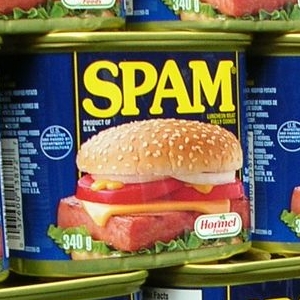I’ve posted about the original Mystery Meat here a number of times in the past, but SPAM has always been a supporting actor – at least a bit player – in those stories. Now, I think, It’s time to give the Iconic Canned Meat product it’s own show. And you just might learn a thing or two…
 This guy actually changed his name legally to I Love Spam. And his human
This guy actually changed his name legally to I Love Spam. And his human
love married him anyway, at the SPAM Museum in Austin TX.
Just about everyone on Earth (in non-Muslim countries) has at least heard of SPAM. An entire generation of Boomers associate it with Monty Python’s Flying Circus; especially, the SPAM Song (‘Spam! Wonderful SPAM!’). Hawaiians have adopted it as a national food, an extension of their age-old affection for the pig, and eat it almost daily. But what is SPAM, anyway? And why is it so iconic in the food sphere?
The first of its kind…
SPAM was invented in 1937 by Hormel Foods in the U.S. as a way of making better use of the Pork Shoulder, not a particularly popular cut of meat at the time. The Shoulder has since become a smokehouse staple, but that’s another story.
SPAM, itself, is Salt-cured, boiled, de-boned Pork which is shredded and compressed into those familiar round-cornered cans. A little of the fat that renders off in the boiling is added back to the mix to help bind it into a manageable loaf.
Name has hazy origins…
The origin and meaning of the name SPAM remains a mystery. The truth was known only to a small group of Hormel executives, legend says, and they’re all long gone. But speculation abounds. I’ve heard, from a host of sources that SPAM’ stands for ‘SPiced hAM’. Others insist it stands for ‘Specially Processed Army Meat’. The latter refers to the fact that the U.S. Army needed a form of Meat protein with a very long storage life to feed its troops in all the various theatres of war.
SPAM goes to War…
Heavily Salted, canned processed Ham was just what the army was looking for. That’s the main reason that SPAM became a household word: Soldiers from all parts of the country and all walks of life often had no other ‘Meat’ to eat in the U.S. Armed Forces, and millions of dads brought home a taste for it from the War. That would also explain how it was introduced to Hawaii. SPAM even became a menu cornerstone in the Soviet Union, where, Stalin claimed, the Red army could not have risen and prevailed against the Nazis without that gift from their western Allies…
SPAM comes home…
But Europeans, especially the British, were still eating SPAM at home, as a mainstay, into the mid 1950s because food was so scarce. Rationing in the UK didn’t end until 1955. Hence the Python’s reference. The same goes for commonwealth countries such as Canada and Australia, where the product was an economical favourite on into the Early 1970s.
The Hormel people leveraged their product for all it was worth after the War, because they had huge manufacturing facilities for it and they wanted to keep selling huge amounts. They came out with menu selections for breakfast (SPAM and Eggs), Lunch (SPAM Salad Sandwiches), and dinner (SPAM Steaks with Mashed Potatoes and Two Veg). Of course, there was always the classic ‘Plain SPAM Sandwich’ (SPAM sliced thick on Plain White Bread) which millions of Boomer kids like me took to school for lunch in their brown paper bags, just like their dads.
SPAM comes of age…
Hormel also suggested different ways of preparing SPAM outside of traditional frying and scarfing ‘raw’, including grilling, baking, and breading. I suppose it’s a credit to the product that you could do with SPAM almost anything you could do with any other ‘cut’ of meat. I remember being served SPAM hors d’oeuvres, once…
SPAM diversifies…
The product began to wane in popularity into the 1970s, and that triggered a thrust by Hormel to diversify. New ‘flavours’ of SPAM came out, with new recipe ideas specifically tuned to them. Another reason SPAM diversified was that the competition was howling at Hormel’s door, trying to capitalize on the unprecedented popularity of SPAM. Names like KLIK and KAM sprang up and they did pretty well, sales-wise, too – though they never really challenged the supremacy of the original, SPAM.
A cult arises…
A popular SPAM cult arose in the mid-to-late 1970s, and it persists to this day. In fact, Hormel caters to its fans shamelessly, with an annual recipe competition and events such as the annual SPAM Jam festival in Hawaii and the SPAM-A-RAMA cook-off in Austin, TX. And there’s even a SPAM Museum in Austin, Minnesota.
Did I mention you can get married, and follow up with a SPAM-themed reception, at the Museum? No, really!
~ Maggie J.

